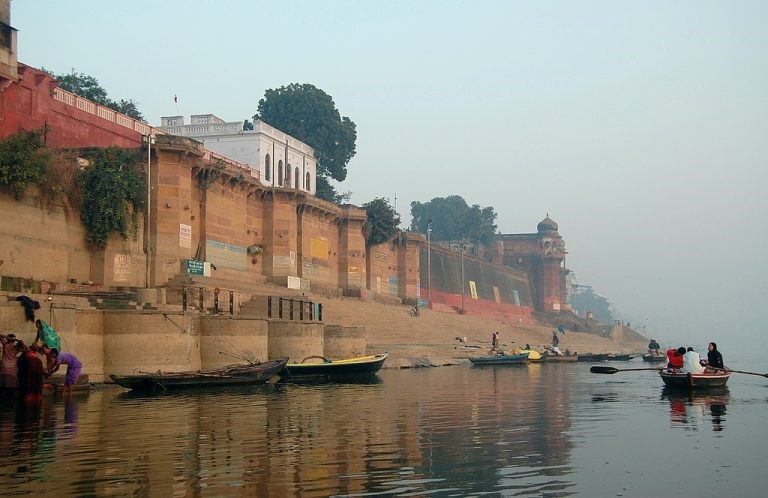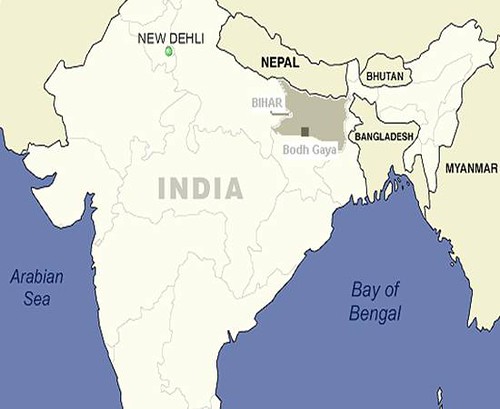
Benares is older than history, older than tradition, older even than legend, and looks twice as old as all of them put together. – Mark Twain
Varanasi, India. With the Kalachakra winding down we bid adieu to the Dalai Lama and head east on this pilgrimage to Varanasi, holy city of Hindus, Buddhists, Jainists – and Jews. One of the oldest continuously inhabited cities in the world and the oldest in India, it is referred often as the “city of lights.” Sunrise and sunsets over the River Ganges are one of the most beautiful and spiritual sights on earth

Sunrise boat cruise on the Ganges where we witness the daily cremations. Photo: author.
As the place where Siddhārtha Gautama gave his first sermon to his disciples after obtaining Enlightenment back in Bodh Gaya where we just were. Varanasi is said to have been designated by Gautama Buddha himself as one of the four pilgrimage sites – the others being Kushinagar, Bodh Gaya, and Lumbini.

Varnasi, the oldest city in India, is one of the world’s longest continuously inhabited cities. Photo: author.
Varanasi is the city where Buddhism was founded. It is also one of the holiest cities and targets of pilgrimage for Hindus. According to legend, the city was founded by the Hindu deity Lord Shiva several thousand years ago, thus making it one of the most important pilgrimage destinations in the country. I understand from an Indian-American friend that various cults connected to Shiva do some pretty gruesome stuff with all the bodies floating about. Many Hindu scriptures including the Ramayana mention the city.

Too foggy to see the sunrise, it just gets gradually less dark and foreboding. Photo: author.
Varanasi is considered a holy city for Jains. Guru Nanak Dev visited Varanasi for Shivratri in 1507 and had an encounter which with other events forms the basis for the story of the founding of Sikhism.

Varanasi attracts tens of thousands of Hindu and Buddhist pilgrims every year. Photo: author.
The city has a sizeable native Muslim population, it hosts the Roman Catholic Diocese of Varanasi, and has a significant Jewish expatriate community. Varanasi, I understand, is home to numerous tribal faiths that are not easily classified.

Man swimming in cold water at one of the 100+ Varanasi ghats (levies). Photo: author
Varanasi has nearly 100 ghats (levies). Most of the ghats are bathing ghats, while others are used as cremation sites (opening photo above). Many ghats are associated with legends or mythologies while many ghats are privately owned.

As the sun rises, the river swells with sight-seers and merchants hawking wares. Photo: author.
Varanasi, I learn, has several small cottage industries including the production of silk saris known for their finery. Interestingly, its silk looms wove the most delicate silks that adorned the halls of St. James and of Versailles. The city also produces carpets said to rival Turkey and Persia.

A beautifully painted houseboat along the Ganges, its inhabitants tucked away for the night. Photo: author.
The city produces about 350 million liters per day of sewer per day and 425 tons per day of solid waste. The solid wastes are disposed in one landfill site. Sadly, a huge amount of sewer flows into the river Ganges daily. Already feeling under the weather, I do my best not to fall in.

Pilgrims and tourists from around the world journey each day onto the Ganges. Photo: author.
Varanasi has been known historically as the city where large wealth and population go hand-in-hand. Other goods it is known for include locally-grown mangoes and brass-ware. Sadly, Varanasi also seems to have a high rate of child labor given the nature of small scale industries here.

Pilgrims and tourists mix easily along the banks of Incredible! India’s Ganges River.
Photo: author.
As a place of pilgrimage for many faiths Varanasi continually hosts an unusually rich diversity of religious practitioners and teachers who are not resident in the city – including the ubiquitous Japanese tourist.

Fighting off a bad cough, which I am soon to discover is pneumonia, I greet the new day.
As I mentioned in the introduction to this series, I am not the first American here. In the 1898 book Following the Equator, Mark Twain wrote about his visit here, calling it by its older name: “Benares is older than history, older than tradition, older even than legend, and looks twice as old as all of them put together.”
I head to the airport, on to Delhi and then Newark. I would like to seek medical attention for my cough and fever, but don’t really know how and am certain my insurance is no help to me here at all. So I push myself in the direction of home, and away from these historic and stirring footsteps of Buddha.
Pilgrimage to Buddha’s Holy Sites
- Main Sites: Lumbini, Bodh Gaya, Sarnath, Kushinagar
- Additional Sites: Sravasti, Rajgir, Sankissa, Vaishali, Nalanda, Varanasi
- Other Sites: Patna, Gaya, Kosambi, Kapilavastu, Devadaha, Kesariya, Pava

See Stories by Jim Luce on:
India | International Development | Philanthropy | Social Responsibility | Tibet
On Pilgrimage: Following the Footsteps of Buddha Across N.E. India: 14 Parts
1. HuffPo: On Pilgrimage: Following the Footsteps of Buddha Across N.E. India
2. Daily Kos: Under the Bodhi Tree in Bodh Gaya Where the Prince Became The Buddha
3. Daily Kos: Photo Essay of Bodh Gaya, Where Buddha Became Enlightened
4. Daily Kos: Next Step of Indian Pilgrimage: Mountain Where Buddha Preached
5. HuffPo: Touching the Untouchable in a Rural Indian Village
6. Daily Kos: Rediscovering the World’s First Great University in Buddhist India
7. Stewardship Report: Buddhism for Beginners: Insights from a Non-Buddhist
8. Daily Kos: Buddhism and the Universal Concept of Social Responsibility
9. HuffPo: Can I Help Support Education and Orphan Care in Bihar, India?
10. Stewardship Report: Most-Photographed Man in the World Prepares to Retire
11. Daily Kos: Varanasi: Holy City of Buddhists – As Well as Hindus, Jainists, Jews
12. Daily Kos: On the Banks of the Ganges: Continuing the Search for My Soul
13. HuffPo: My Pilgrimage Complete: Lessons Learned, Life Continues Like a Wheel
14. Daily Kos: Pilgrimage Postscript: Pneumonia and Possible T.B.
Varanasi: Holy City of Buddhists – As Well as Hindus, Jainists, Jews.
Originally published in Daily Kos, Jan. 19, 2012. Edited by Ferdi Kayhan.